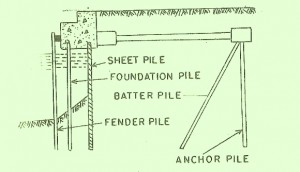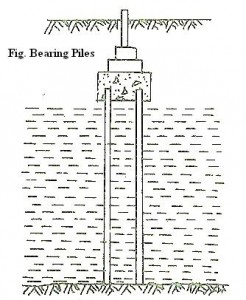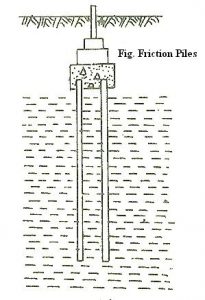Depending upon their function, the different types of piles are,
- Bearing piles
- Friction piles
- Sheet piles
- Anchor piles
- Batter piles
- Fender piles
- Compaction piles

(i) Bearing piles: Bearing piles are those which are driven into the ground until a hard stratum is reached. Such piles act as pillars supporting the super-structure and transmitting the load down to the level at which it can be safely borne by the ground. Thus bearing piles, by themselves do not support the load, rather they act as a medium to transmit the load from the foundation to the resisting sub-stratum.

(ii) Friction piles: When piles are required to b driven at a site where the soil is weak or soft to a considerable depth, the load carried by a pile is borne by the friction developed between the sides of the pile and the surrounding ground (skin friction). In such cases the pile is named as friction or floating pile. Thus friction piles are driven in the type of soil whose strength does not increase with depth or, where rate of increase in strength with depth is very slow.

(iii) Sheet piles: Sheet piles differ from bearing or friction piles in that they are rarely used to furnish vertical support but are used to function as retaining wall. Sheet piles are used for retaining soil that is liable to escape laterally when subjected to pressure or to enclose the area required for some foundation and protect it from the action of running water or leakage.
(iv) Anchor piles: When piles are used to provide anchorage against horizontal pull from sheet piling walls or other pulling forces, they are termed as anchor piles.
(v) Batter piles: When piles are driven at inclination to resist large horizontal or inclined forces,, the piles are termed as batter piles.
(vi) Fender piles: When the piles are used to protect concrete deck or other water front structures from the abrasion or impact that may be caused from the ships or barges (when they are tied up at the deck) they are called fender piles. The fender piles are ordinarily made up of timber.
(vii) Compaction piles: When piles are driven in granular soil with the aim of increasing the bearing capacity of the soil, the piles are termed as compaction piles.
